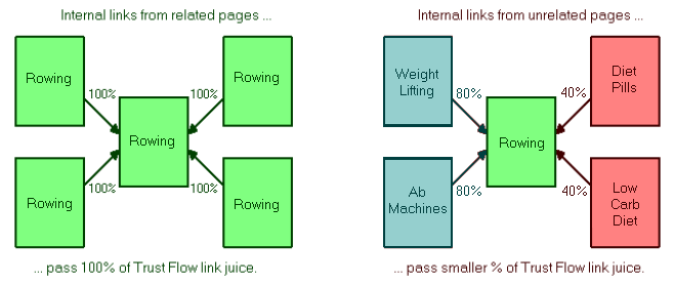How to Silo Your Site For SEO
 In the last article, we discussed site architecture and how to link internally within your site. It was an accurate description of how you should link within a smaller site that is based on a single niche. What should you do if you want to create a massive website which contains more than one subject?
In the last article, we discussed site architecture and how to link internally within your site. It was an accurate description of how you should link within a smaller site that is based on a single niche. What should you do if you want to create a massive website which contains more than one subject?
Let’s assume for a moment that you want to create a website on health related issues. The topics you will cover are exercise, with subtopics of yoga, jogging and Pilates. Another category might be weight loss, featuring various tips and tricks for losing weight, diet pills and low carb dieting. A final category might be on exercise equipment, featuring rowing machines, weight lift machines and ab machines.
A tentative menu structure would look something like this:
- Exercise
Yoga
Jogging
Pilates
- Weight Loss
Tips
Diet Pills
Low Carb
- Equipment
Rowing
Weight Lifting
Abs
You’ll notice that these topics are somewhat close to each other. It is still a good idea that your site’s topics not be all over the place. You could have easily made a site about health and fitness where any article about the above topics would be similar enough that interlinking between them would be acceptable. However, an article about rowing would only be partially related to an article about yoga.

Above we see another breakdown of internal linking. This is an explanation of how those internal links may benefit other pages within your site. In the first instance, we took the topic of rowing, and assume we have five articles total – one being linked two, and four other pages doing internal linking within content to a particular page. The first scenario assumes all four articles are about rowing machines.
In that case, those pages carry full weight, and benefit the linked-to article at the highest level possible. Because all articles are on the exact same topic, they pass along topical trust flow at the maximum level. The rowing page being linked to will receive the highest boost in Google’s SERPs.
On the other hand, let’s assume that we weren’t being as pure about linking from other internal articles which were most related. There may be two other articles on exercise equipment, that focus on abs and weight lifting. Another two focus on diet pills and weight loss.
You can see how the articles on weight lifting and ab machines are closely related to rowing exercise equipment. Rowing is a type of weight lifting machine – furthermore it works on your abs. Because these topics are more closely related, they’re more likely to pass relevant link juice that is more effective. We’ll say these links pass approximately 80% of the link juice that another rowing machine article would pass.
Conversely, the next two articles are less relevant. Low carb dieting and diet pills are far less relevant to an article on rowing machines. Both can be considered in the same general category of health and fitness. While using a rowing machine could technically help you lose weight, that category is far less related to diet pills and low carb dieting than other rowing machine articles would be. Let us say that these articles pass a relevant topical trust flow of 40%.

How does Google know that the topics are related? In 2008, Google already had over a trillion web pages indexed. Far more are indexed today. Google knows which terms are relevant to each other. They have specific percents recorded, how often pages on rowing machines link to pages on low carb dieting for instance. There are many ways Google can detect how relevant a topic is to another topic. We can assume that whatever Google has cooked up, it is light years beyond Majestic’s topic-specific Trust Flow.

The idea behind siloing is to limit your internal linking to only the most relevant pages. Instead of having dozens of outgoing links on each page, that range from 10% to 100% relevant, the only links you’ll be doing will mostly be 100% relevant. That will increase the effectiveness of your internal links.
Following is the example menu system we’ve been using.
- Exercise
Yoga
Jogging
Pilates
- Weight Loss
Tips
Diet Pills
Low Carb
- Equipment
Rowing
Weight Lifting
Abs
That represents a base of 12 links on every single page of your site. Some sites have a menu system that contains hundreds of links. This significantly reduces the relevancy of your internal linking. It would be far more effective to reduce the links per page.
For instance, instead of featuring the above menu system, you could instead only link to Exercise, Weight Loss and Equipment. Then, while browsing the equipment section, you may see sub-links to rowing, weight loss and ab machines. This brings the 12 default links per page down to 6, cutting your links in half – but more importantly, increasing the relevancy of your internal links.
 Content is the best place to link to other pages, using in-content links. On a page where you’ve implemented the siloing techniques mentioned above, your internal linking is literally twice as powerful, because each page has only half the outgoing links. That gives more weight per link.
Content is the best place to link to other pages, using in-content links. On a page where you’ve implemented the siloing techniques mentioned above, your internal linking is literally twice as powerful, because each page has only half the outgoing links. That gives more weight per link.
This might not seem like a big deal when you’re dealing with a menu of 12 items. Other sites I’ve worked on, where the menu systems contain hundreds of links per page, receive a significant boost when implementing a siloed link structure.
There are other implications for on-page SEO that are improved with using siloing. Quite simply, a menu system that consists of hundreds of links dilutes the effectiveness of your page’s ability to rank beyond the links you create. Simply having an extra 100+ words on every page that are unrelated to the topic of the page (or only partially related) dilutes the specific niche of the page.
Properly siloing your site is the on-site equivalent of getting more relevant links to your site. If your website is about health and fitness, obviously a link from a health and fitness magazine is going to do you far more good than a link from a dog training website. While we all fully realize this regarding external links, we often do not take into consideration that the same problems can occur with internal links.
Your website is fully in your control. While controlling the relevancy of external links your site receives can be much more difficult, increasing the relevancy of your internal linking through siloing is something any webmaster can do. Give it a try on your site, there are many free wordpress silo plugins available.

Comments